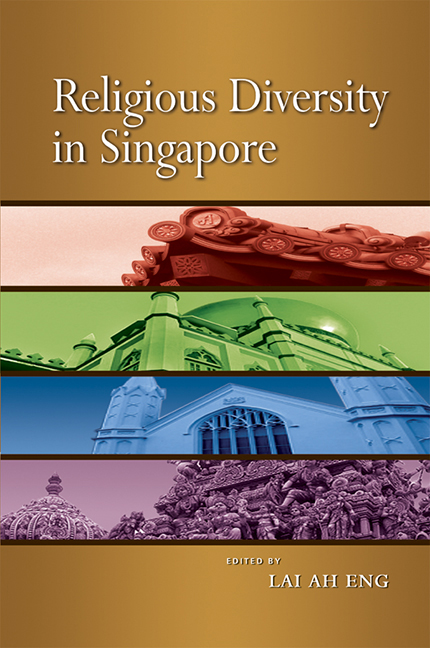Book contents
- Frontmatter
- Contents
- List of Figures and Tables
- List of Appendices
- FOREWORD
- PREFACE
- Acknowledgements
- The Contributors
- Abbreviations
- Glossary
- INTRODUCTION
- PART I The Landscape of Religious Diversity
- 1 Religious Influences and Impulses Impacting Singapore
- 2 Religious Trends and Issues in Singapore
- 3 Keeping God in Place: The Management of Religion in Singapore
- 4 Discourses on Islam in Southeast Asia and Their Impact on the Singapore Muslim Public
- 5 Global Christian Culture and the Antioch of Asia
- 6 “Religiously-inspired”, “India-derived” Movements in Singapore
- 7 Baha'is in Singapore: Patterns of Conversion
- 8 Diversities and Unities: Towards a Reformist Buddhism in Singapore
- 9 The Sathya Sai Baba Movement in Singapore: Its Service Mission and Philosophy of Communal Identity Construction
- 10 The Muslim Religious Elite of Singapore
- 11 The Evolution of the Sikh Identity in Singapore
- 12 Religious Processions: Urban Politics and Poetics
- PART II Religion in Schools and Among the Young
- PART III Religion in the Media
- PART IV Religious Organizations in Social Services
- PART V Interfaith Issues and Interaction
- Index
2 - Religious Trends and Issues in Singapore
from PART I - The Landscape of Religious Diversity
Published online by Cambridge University Press: 21 October 2015
- Frontmatter
- Contents
- List of Figures and Tables
- List of Appendices
- FOREWORD
- PREFACE
- Acknowledgements
- The Contributors
- Abbreviations
- Glossary
- INTRODUCTION
- PART I The Landscape of Religious Diversity
- 1 Religious Influences and Impulses Impacting Singapore
- 2 Religious Trends and Issues in Singapore
- 3 Keeping God in Place: The Management of Religion in Singapore
- 4 Discourses on Islam in Southeast Asia and Their Impact on the Singapore Muslim Public
- 5 Global Christian Culture and the Antioch of Asia
- 6 “Religiously-inspired”, “India-derived” Movements in Singapore
- 7 Baha'is in Singapore: Patterns of Conversion
- 8 Diversities and Unities: Towards a Reformist Buddhism in Singapore
- 9 The Sathya Sai Baba Movement in Singapore: Its Service Mission and Philosophy of Communal Identity Construction
- 10 The Muslim Religious Elite of Singapore
- 11 The Evolution of the Sikh Identity in Singapore
- 12 Religious Processions: Urban Politics and Poetics
- PART II Religion in Schools and Among the Young
- PART III Religion in the Media
- PART IV Religious Organizations in Social Services
- PART V Interfaith Issues and Interaction
- Index
Summary
INTRODUCTION
This chapter presents an analysis of the religious landscape in Singapore, beginning from the early days of its founding to the present, using census data. The picture that emerges is one where the society is marked by a high degree of multi-religiosity as well as significant changes in the religious landscape. In different periods, religions have waxed and waned. Some, such as Christianity, have been very successful in recruiting members. Others have seen their membership decline. The data also shows that there is a correlation between religious affiliation and several socio-demographic variables, including age, education, occupation, and socio-economic status. For example, Christians in Singapore tend to be younger, more educated and have a higher socioeconomic status. Obversely, Taoists tend to be older, less educated and come from lower socio-economic groups. This structural differentiation will be analysed and discussed. Another key variable is ethnicity. Despite being a multi-ethnic and multi-religious society, religious affiliation is culturally or ethnically structured to some extent. Most Malays are Muslim, most Indians Hindu, and Chinese, to a lesser degree, adopt Chinese religions.
THE EARLY RELIGIOUS LANDSCAPE
At the point when Sir Stamford Raffles landed in Singapore in 1819, it was believed that there existed an Orang Laut2 population of no more than 150 (Song 1984). This community was believed to have “long been converted to Islam” (Evans 1927). However, other accounts exist. Bartley (1933) suggests that the population was larger, and certainly included Chinese, as there were already gambier plantations owned and cultivated by the Chinese prior to 1819. Bloom (1986) cites some estimated figures: a total population of about 200, consisting of a few Orang Laut families, about a hundred Muslim Malay fisher folk (thought to have settled on the island in 1811), and a community of about forty Chinese pepper and gambier cultivators. The Chinese were likely to have adhered to a form of Chinese religion.
As with Islam, archaeological and historical evidence suggest that Buddhism and Chinese religion of some form existed in Singapore prior to Raffles’ arrival. Ke (1984) cites eye-witness accounts of the remains of Buddhist sacred architecture on Fort Canning in 1822, suggesting the existence of a pre-Islamic population in Indianized Southeast Asia, including Singapore.
- Type
- Chapter
- Information
- Religious Diversity in Singapore , pp. 28 - 54Publisher: ISEAS–Yusof Ishak InstitutePrint publication year: 2008



